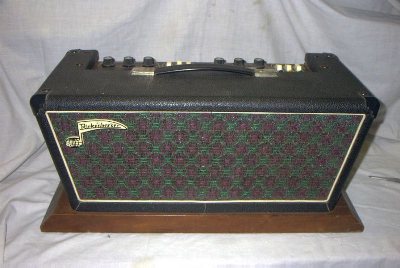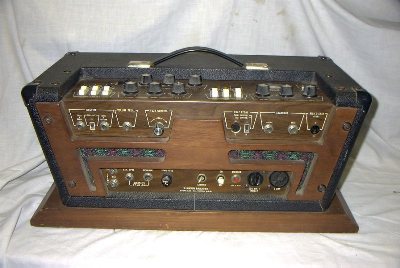 |

|

|

|

|

|

|

|
Transonic Series
Now on to a real legend, the only Rickenbacker amplifier series to have been endorsed by real rock stars. Very few other amplifiers are that distinctive: check the '68 Rickenbacker Catalog for that groovy vibe. The ads said "Whatever turns you on"...

|
Steppenwolf, whose guitars comprised a 381, a Combo 800 and a 4001, also used Transonics on stage and for TV shows (Music Bag in 1969). Led Zeppelin used them on their first american tour in 1969, Jimmy Page being backed by two of them. The Jeff Beck Group had also Transonics on their 1968 US tour.
While these amplifiers' trapezoidal shape, tutti frutti colors, varnished woods, and high technology made at first a thrilling impression, it is clear the elective affinity with these young Brits didn't last very long. Pictures of the Jeff Beck Group 1969 US tour show a wall of Kustoms - yes, other solid-state amplifiers with off-the-wall enclosures - and Led Zeppelin simply left their amplifiers behind on their trip back to England. By the way, these very Transonics were picked up by a certain Tom Petersson (of Cheap Trick) who refurbished them, changing the power amplifier and the speakers - he still played them until recently.
They were designed at the end of the sixties by Bob Rissi, ex-Fender amp designer who later built the Risson amplifiers. Their panel featured a bunch of controls and plugs, the whole nine yards: volume, treble, bass, reverb, tremolo, fuzz, volume pedal jack, fuzz pedal jack, Rick-O-Gain output, various switches (pierce, hollow, mellow...) and lights, and even a VU-meter (temperature indicator!) Cabinets usually featured 4x12", 1x15"+2x12" or 2x15" Altec Lansing speakers. A castor-mounted cradle allowed to tilt the amplifier back and forth, allowing the musician to adjust the speaker position, a bit like those Vox AC-50 cabinets.
The Transonic 100 was a combo model rated at 200W (peak power) with an open back, controls on top. A very rare Transonic 70 was a stripped-down version of the model 100: no fuzz, just the basic controls and two 12" speakers.

|

|
The Transonic 200 was a stack giving 350 Watts (peak power). The Rick-O-Gain option allowed to plug a power amp and another cabinet, delivering up to 700 Watts. A possible setup was to mount the second cabinet upside down on top of the first, forming a truncated lozenge, the two heads being hung on the sides of the top cabinet - looking like the arms of a headless robot from a 30's sci-fi flick. The bass version could be augmented to a total of three cabinets, which was ok if you had an army of roadies...
The schematics for these models haven't been made public on the RIC site, mostly because of their excessive size. Anyway, even if Bob Rissi was still at Fender when CBS pushed their ill-fated transistor amplifiers - at the same time they designed the infamous first silver face tube amps - he surely didn't want to make the same mistakes, and must have designed a different circuit. While most transistor amplifiers are put down, usually for good reasons, nobody complains about the solid state Rickenbacker sound.
The world was not ready, however, for such monsters. Production a stopped after only two or three years and a few hundred specimens.
In 1972, Bob Rissi launched his own line of solid-state amplifiers, such as the behemoth below:

|
The panel, true to its kin, is populated with two inputs (normal/distort), four "mode" switches (thin, brite, middle, heavy), one tremolo switch (fast/slow), one reverb switch (dwell/mix), eight knobs (response level, preamp volume, treble and bass, tremolo depth and speed, reverb output and input), a yellow overload light, a red "pilot" light, a level VU-meter, a ground switch, and finally an on/off switch.
Update: Bob Rissi wrote me an email confirming the story above."I have been in computers 20 years, but I am going to build amps again in the near future."
And he's back, as testifies Risson's site displaying his bio as well as a rare find: Jimmy Page torturing a Telecaster in front of two Rickenbacker Transonics.
He concludes: "I was one of the young ones. Lucky I guess."
This site is in no way associated with Rickenbacker International Corporation. Rickenbacker®, RIC, and logos are trademarks of Rickenbacker International Corp.